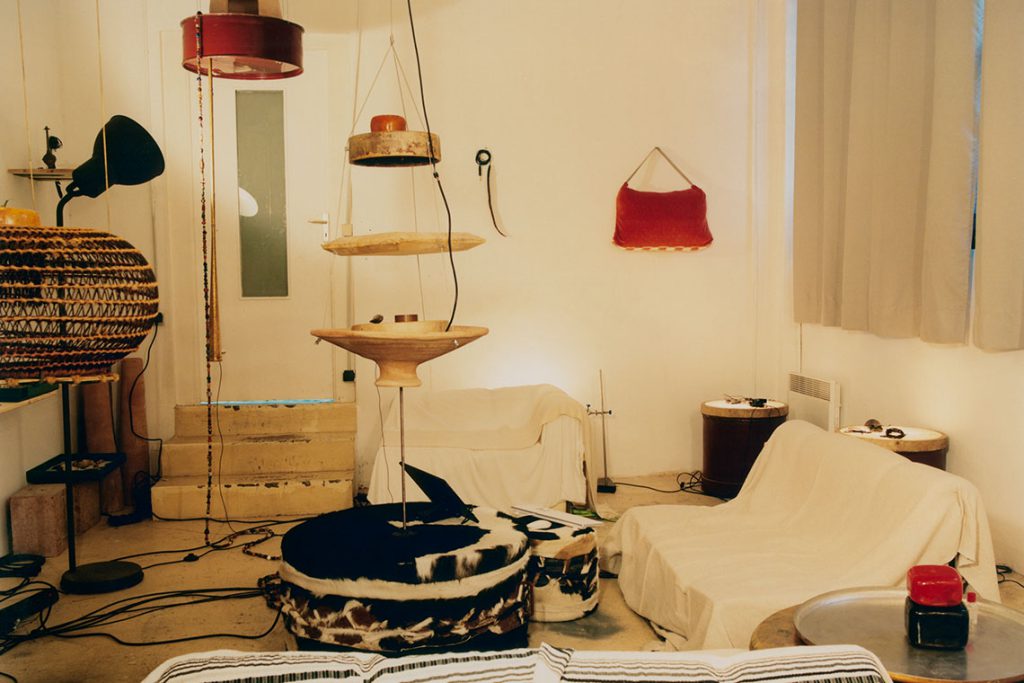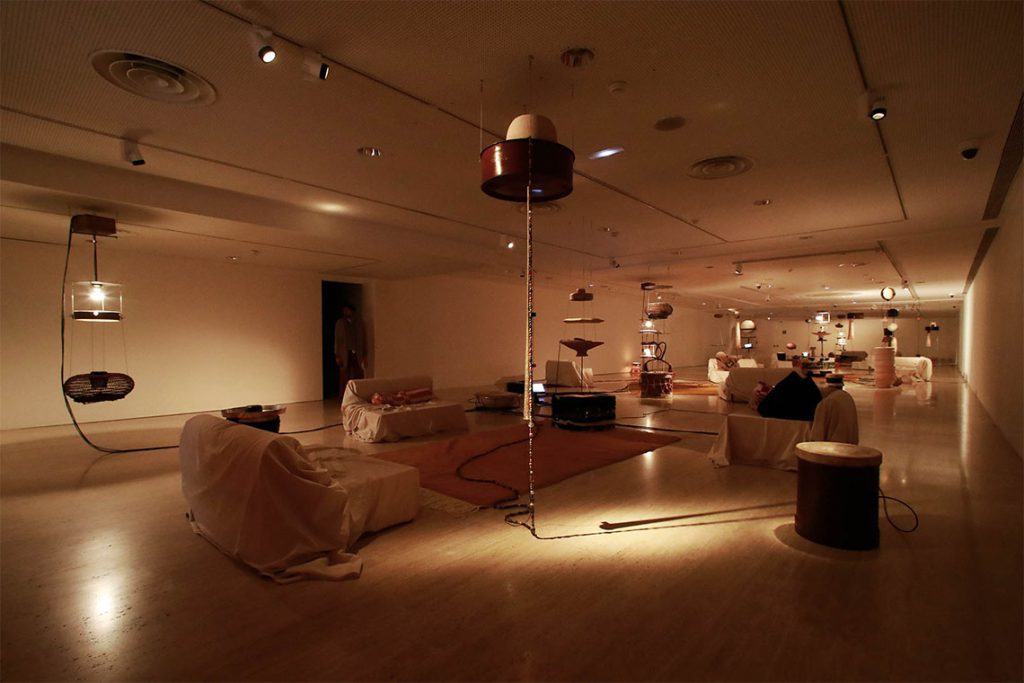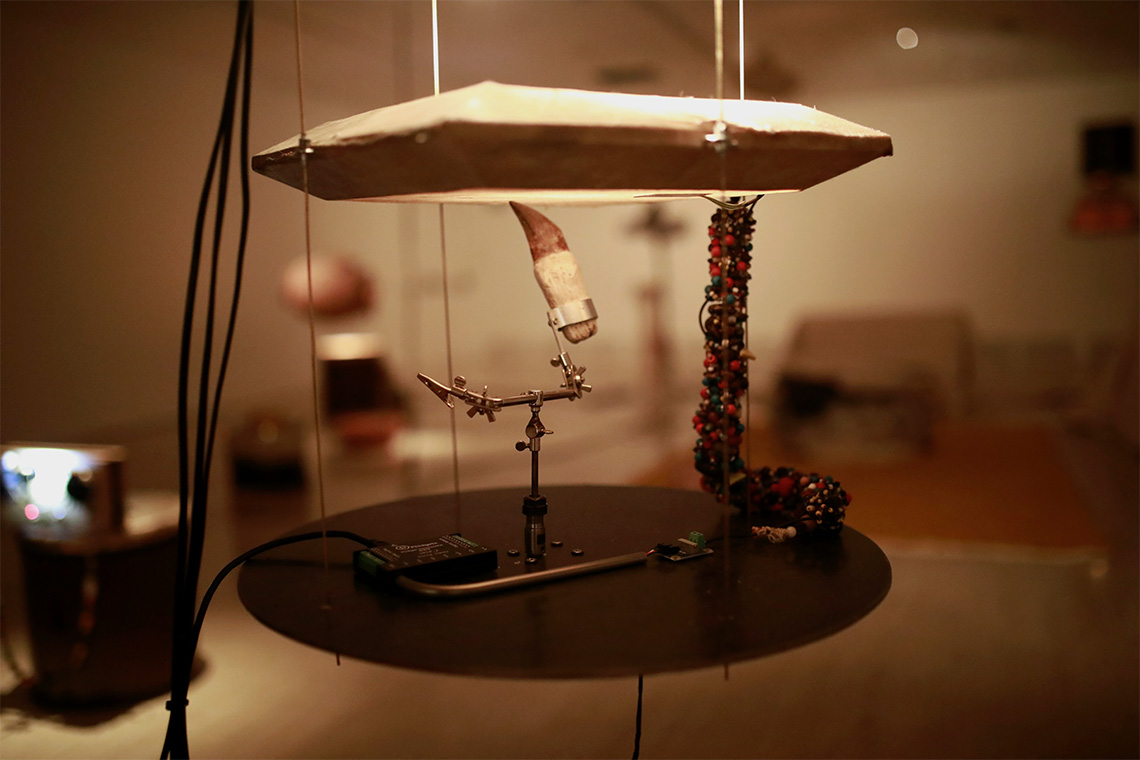Inspired by the music traditions of North Africa, Tarek Atoui explores the power of sound, reflection and provenance in At-Tāriq, his current solo show at the Thyssen-Bornemisza National Museum in Madrid.
The TBA21 basement gallery at Madrid’s Thyssen-Bornemisza National Museum is a noisy space – both visually and aurally. Upon entering Tarek Atoui’s installation, At-Tāriq, the visitor’s quick first impression is of a darkly lit room packed with what reads as piles of clutter. There are stacks of unrecognisable objects, bits and pieces hanging from the ceiling, and whereas most galleries tidy away their electronic cabling, here countless chords spread across the floor in a chaotic mess.
Slowly, a semblance of logic emerges from the arrangement. There are several large yellow carpets, each with chairs invitingly positioned in a nominally domestic arrangement. Once reclined into, they are hard to leave – not only because of their soft comfort but also because their low height and deep seat seem designed to force the visitor to remain in place, trapped in a restful welcome.
Tarek Atoui’s title refers to the 86th surah of the Qur’an, the Morning Star or Nightcomer, with both meanings relating to the conceptual root of a project that began in Córdoba and is set to continue far beyond this TBA21 installation. In 2023 Atoui hosted a residency in the Spanish city with fellow musicians Ziúr, Susie Ibarra and Nancy Mounir, and while there encountered varieties of Andalusian music that intrigued him through their connections to the music of the Amazigh people of the Atlas Mountains in both form and instrument, even though it had developed and fused with other influences into its own form. “As somebody who comes from the Levant in the Middle East, it is hard to visit Andalusia with innocent eyes,” Atoui says. “I want to look at what Muslim heritage became, and this idea of the Andalusian music was on my mind.”
Atoui had pre-existing experiences with the music of the Maghreb through previous projects connected to Lebanon’s AMAR Foundation, which houses the largest collection of early twentieth-century Arab music recordings. However, after talking to Daniela Zyman, curator of At-Tāriq, in Córdoba, he decided it was time to begin a deeper research project exploring the Atlas Mountains, looking for the musical roots and cultures and their practice in everyday life.

Whenever visiting Morocco, Atoui collected CDs and cassettes of music, but “not the latest releases – the things that bus and taxi drivers put on”. As much as the music, Atoui admired the low fidelity of the recordings: bootleg copies; repeatedly rerecorded music with added patina and noise; street music recorded on phones then onto CD, including noises of traffic, talking and kids playing. It spoke to the artist of the value of aural culture and of how a truth of people, place and music is not in singular polished, produced artefacts of culture but within the careful act of making, presence, observing and listening.
Atoui then started a project to find the sounds from these recordings, travelling into the Atlas Mountains and turning up at homes, sometimes unannounced (as a nightcomer may) seeking shelter and accepting generous hospitality. He met musicians, was given recordings on memory sticks and CDs, visited instrument makers and – most importantly – spent time listening. The installation, At-Tāriq, is Atoui continuing that aural tradition, recording the music he found not as an ethnomusicologist but as a fellow musical practitioner wishing to continue the musical journey. Much of the soundscape created at TBA21 is formed of these recordings, variously layered, edited, reformed and explored.
The installation comprises several amplifiers, many concealed within the stacked and suspended sculptural objects. These are all made with instruments and materials also encountered on his journeys: 200 metres of the cables connecting it all are clad in Moroccan beads; wicker, ceramic and wood pieces were made by craftspeople from the region; fossils from the mountains sit in piles; the seats are covered in handmade textiles; and those five carpets were made by women cooperatives, traditionally dyed with saffron to give a warm yellow hue.
These materials are not solely about a visual aesthetic but are also all complicit in the aural experience. The sound work that Atoui has made in collaboration with musicians Ziúr, Susie Ibarra and Nancy Mounir, along with his archive of found recordings, is played on a long loop in a rich, exploratory surround-sound experience through microphones secreted inside and upon the collection of material artefacts. Recorded music is played within the drums, ceramics and objects to amplify sounds through materials of the landscapes it came from. Often, digital and analogue compress, so it is not clear to the listener which elements are recordings and which are made by the objects in the space. A drum beat amplified from within a Moroccan drum leads to fossils vibrating upon its stretched skin, adding new percussion; a machine that looks like a reel-to-real tape player is listening to glass beads with a bright light shining through them to a sensor, turning geology to sound; a dinosaur tooth scrapes across a drumskin; water ripples and drips. “We are used to headphones and high-fidelity music systems,” Atoui says of this analogue/digital interplay, “but here it is wilder, it travels through the materials, potteries and metal barrel and has a resolution that is a bit murky, somehow hazy.”

This makes for a layered listening experience that encourages moving around the space, getting up close to each object as well as spending time deeply reclined at each of the five yellow-carpeted majlises. “From a sound perspective, it’s like different bands playing at the same time, you see and are aware of each part in a certain form of harmony,” Atoui says. “You hear the same sound piece in all five spaces, but at the same time each of them has a different particularity.”
This loss of threshold and need to move through the space is political as well as sensorial. By experiencing it from only one position, the listener would never truly experience the work, but if they migrate around it, pay attention, explore it visually and aurally from different angles, they will understand that to try and understand something from only one perspective will never reveal nuance or truth – just as Surah At-Tāriqencourages reflection beyond the immediate. A music journeyed across land and seas, and as Atoui himself journeyed into and over the Atlas Mountains, so too the listener to At-Tāriq must journey the work, listening and thinking around it and into it.
This is only the beginning of a research project the artist imagines going on years into the future, taking him into geographies beyond the Atlas Mountains on a pilgrimage to countless unknown destinations. Where an ethnomusicologist would document, order, classify and accurately record the sounds they encounter, Atoui will fold them together into his own compositions, performances and artworks, as well as into the materials and objects he collects on the way. This does not mean future iterations of At-Tāriq will grow in scale, or have more carpets and majlises, but that the work will expand, edit and transform organically. Atoui explains it as a porous structure, “although here it looks compact, because technically, aesthetically and sonically the five channels are emblematic of a nomadic journey. In the future, I see them each going in a particular direction, as each is a nucleus around which more things can be built.”
Over the years to come, At-Tāriq may split up, objects may decay, new pieces be added, new microphones inserted into currently empty vessels, freshly found sounds added to the score, newly made or discovered vernacular materials, instruments, and crafted pieces folded into the mix, and the soundscape could evolve into richer, deeper explorations. It is the start of a new aural archive, one rooted around poetics, proximity, distance and decay.
This article first appeared in Canvas 117: The Maghreb Issue



